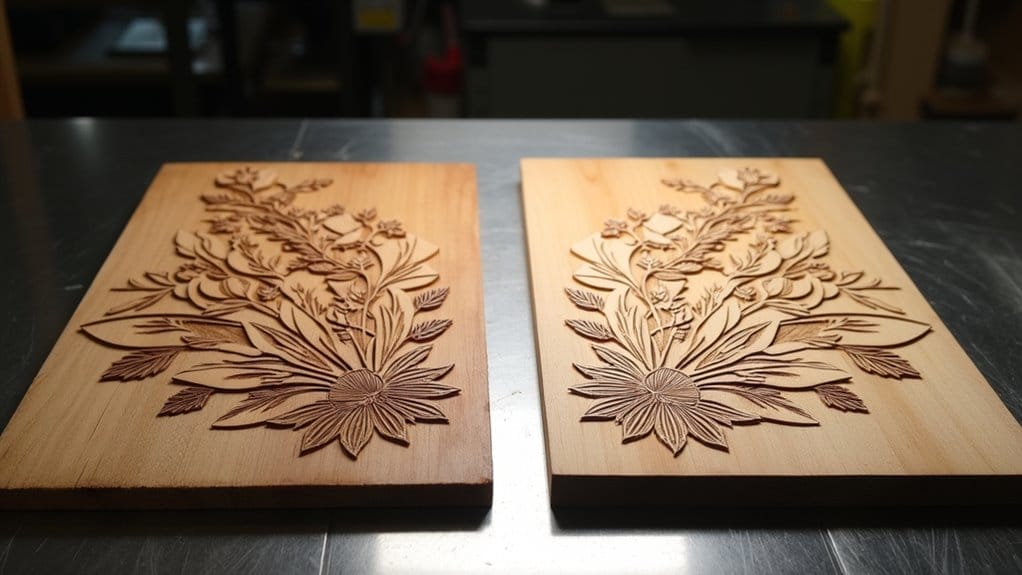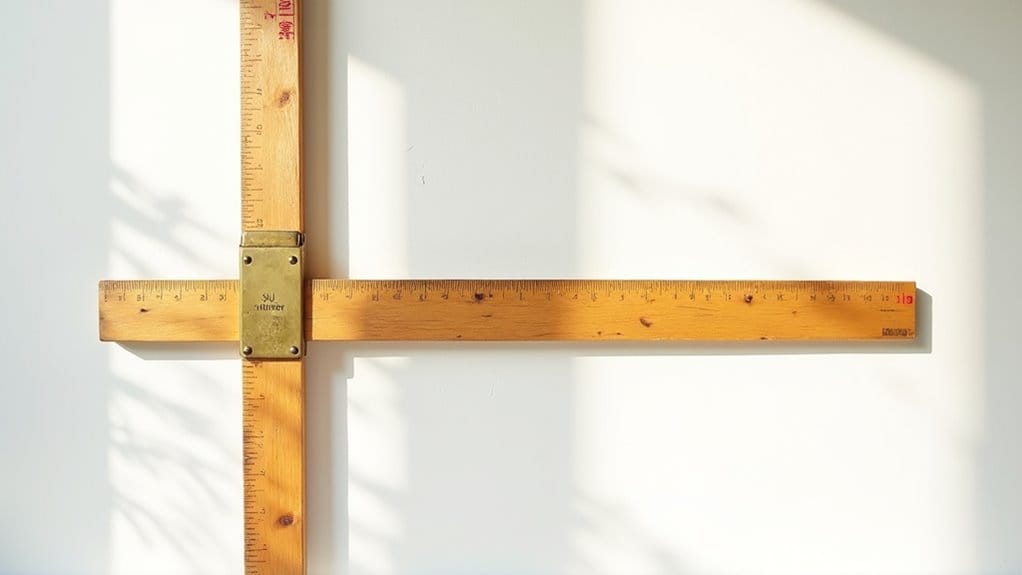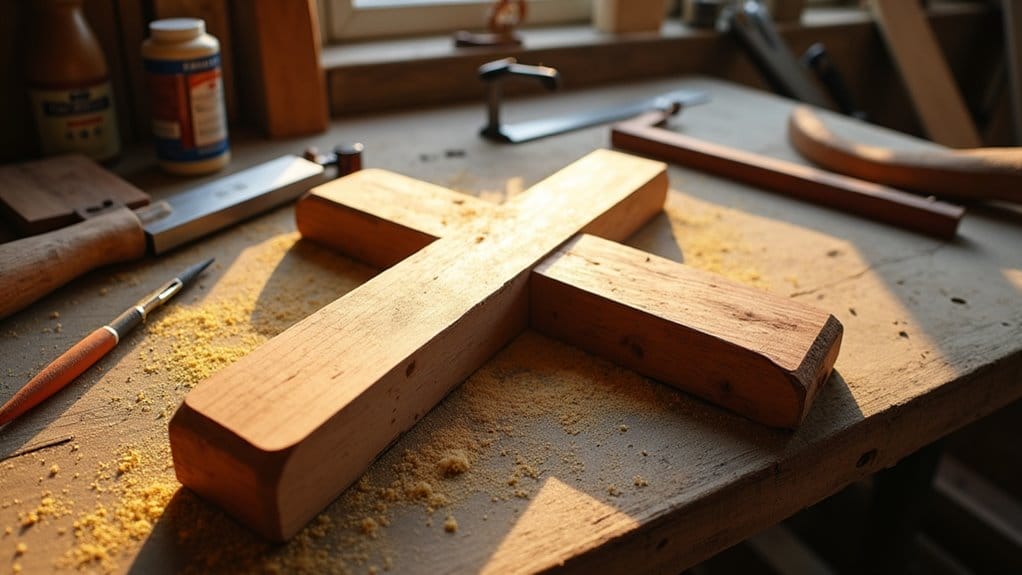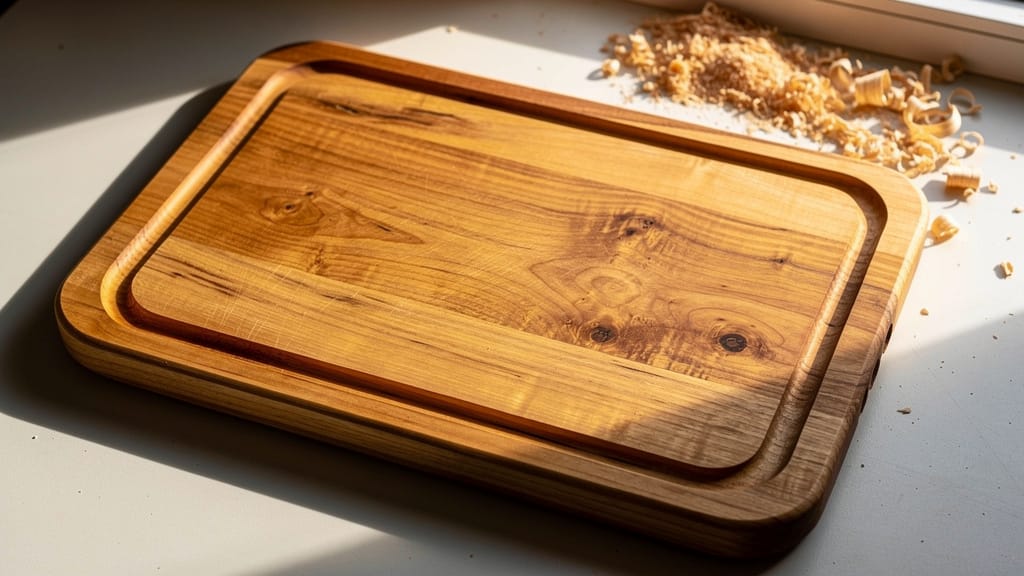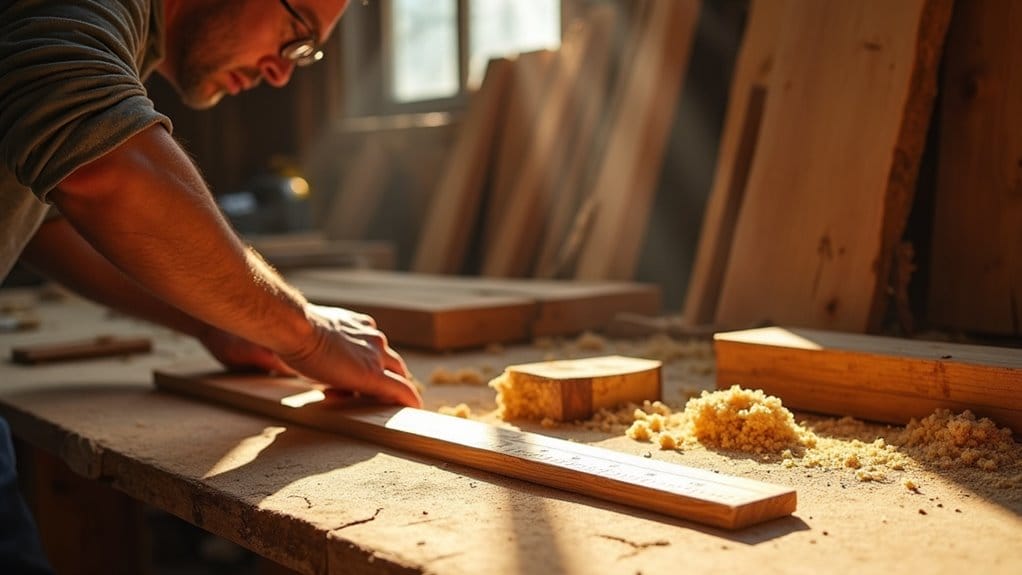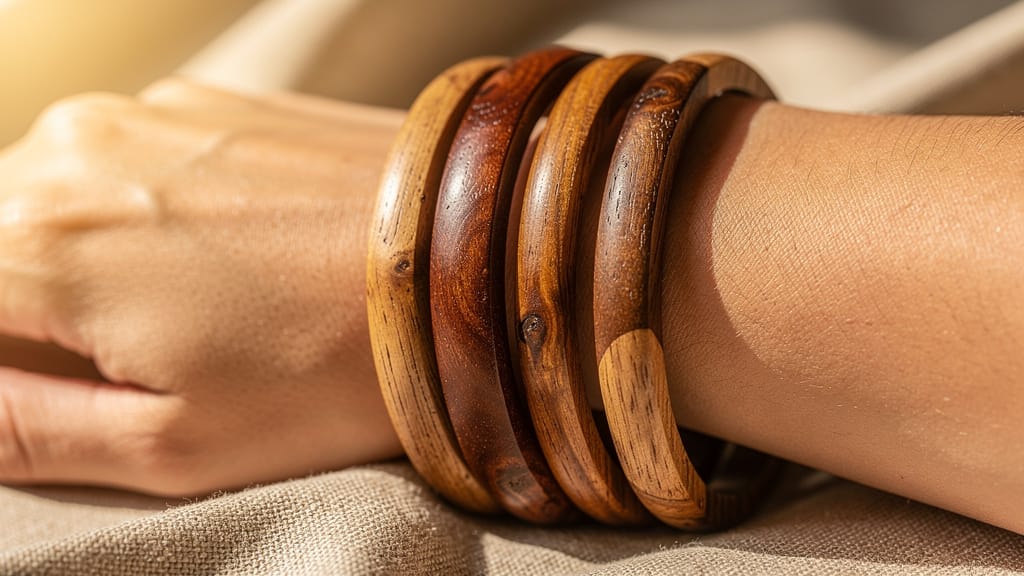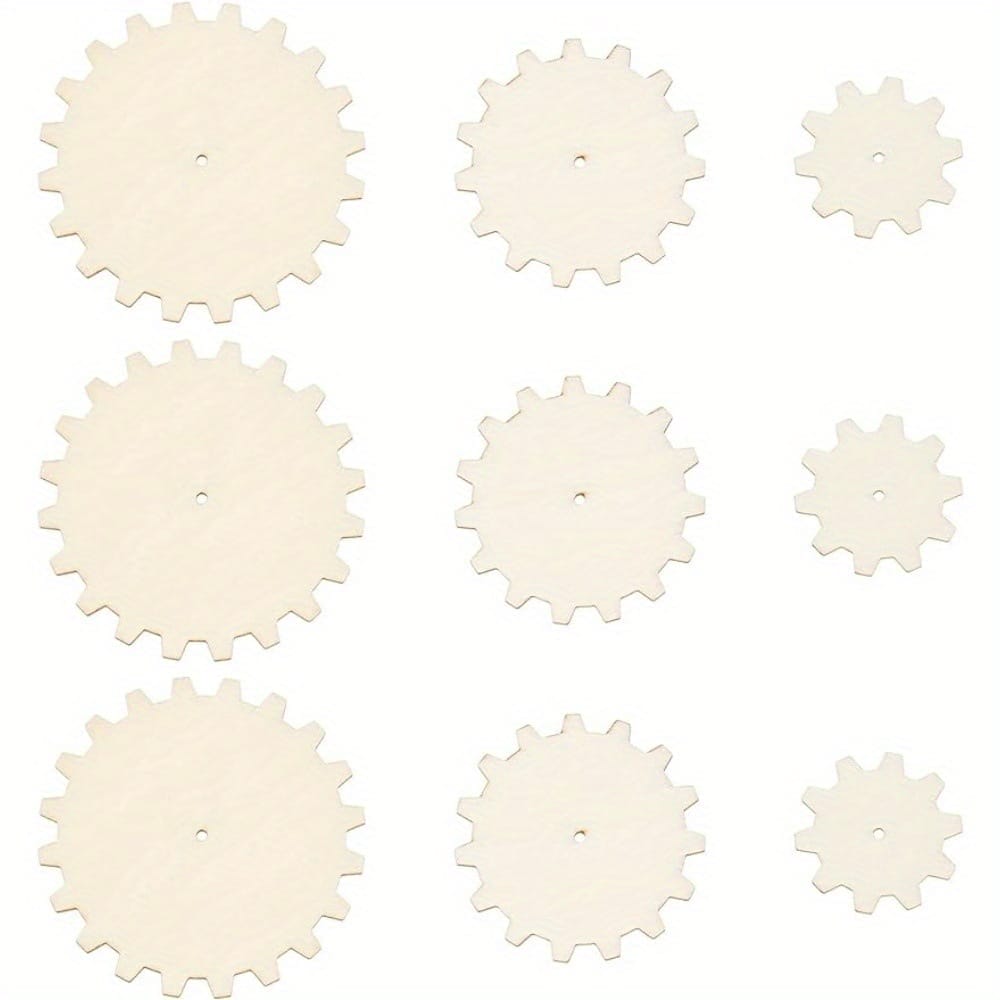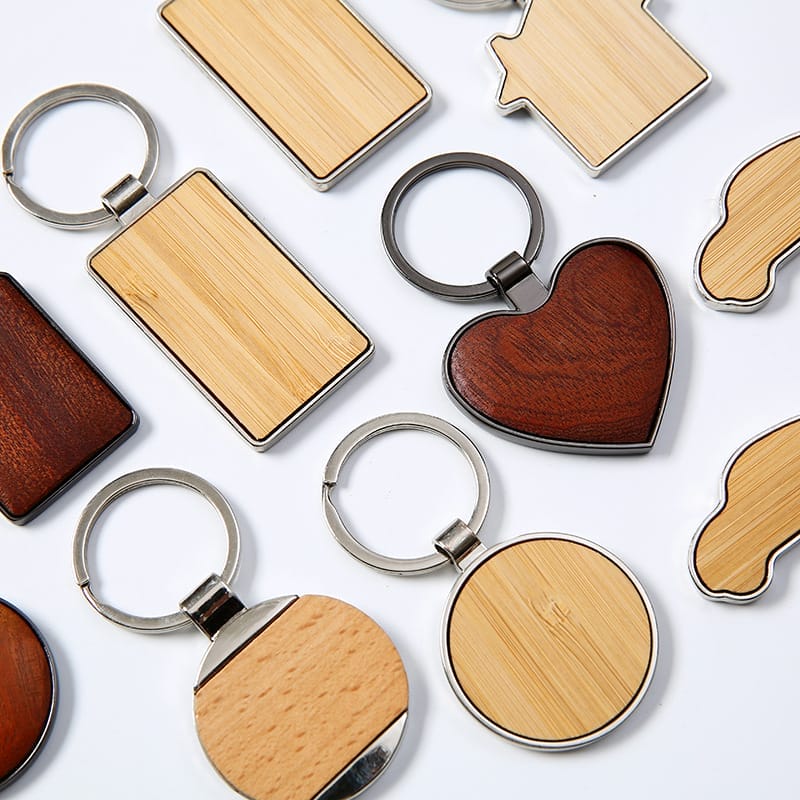When you’re crafting laser cut earrings, your choice of wood can make or break your project’s success. You’ll need to evaluate several vital factors: the wood’s density affects cutting precision, grain patterns influence aesthetic appeal, and material stability determines long-term durability. Whether you’re working with popular birch plywood or exploring exotic hardwoods, understanding these material characteristics will help you achieve professional results and avoid common pitfalls that can compromise your designs.
Key Takeaways
- Birch plywood offers exceptional stability and clean cutting properties, making it the top choice for laser-cut earrings.
- Hardwoods like maple provide superior durability and polish, ideal for long-lasting jewelry pieces.
- Wood thickness impacts laser settings, with 3mm being optimal for earrings when using 40-50W CO2 lasers.
- Tighter grain patterns yield cleaner cuts and better finish adherence, affecting the final appearance of earrings.
- Test cuts on scrap pieces help determine ideal power settings: 65-75% for hardwoods, 40-50% for softer woods.
Characteristics of Popular Wood for Laser Cut Earrings

When choosing the best wood for laser cut earrings, you’ll need to evaluate both density and grain patterns, as tighter grains produce cleaner cuts while varying densities affect the cutting power required.
Your choice of wood species will determine the natural color palette available, from light maple to rich walnut, with each type accepting stains and finishes differently.
The wood’s surface texture and porosity directly impact how well it takes a finish, which affects both the final appearance and durability of your earrings.
Density and Grain
The density and grain characteristics of wood profoundly impact the quality and durability of laser cut earrings.
You’ll find that hardwood species with uniform grain patterns and higher density offer cleaner cuts and better polish. Dense wood types resist warping and breakage, making them ideal for delicate designs. When selecting materials, look for tight, consistent grain patterns that won’t splinter during cutting.
High-quality plywood can be an excellent alternative, offering dimensional stability and reduced warping potential. The layered construction provides strength while maintaining a lightweight profile.
Remember that less dense woods may require multiple passes during cutting and mightn’t achieve the same refined edge quality.
Color and Finish
Natural wood colors and finishes enhance the aesthetic appeal of laser cut earrings while highlighting their unique grain patterns.
Different wood types offer distinct color variations – cherry wood provides rich reddish-brown tones, walnut delivers deep chocolate hues, and birch offers lighter, cream-colored surfaces.
You’ll find that darker woods often create more dramatic contrast when laser engraved, while lighter varieties show more subtle detail.
The natural finish of each wood type responds differently to laser cutting, affecting both the edge quality and burn contrast.
Consider applying a clear protective finish to preserve the wood’s natural color and protect against wear.
Best Wood Types for Laser Cut Earrings

When selecting wood for laser cut earrings, you’ll find that birch plywood and basswood offer excellent cutting precision due to their uniform grain structure and minimal resin content.
Maple, walnut, and cherry provide superior durability and rich color variations, making them ideal for statement pieces that require intricate detail work. These hardwoods also maintain crisp edges during the laser cutting process, though you’ll need to adjust your laser settings to accommodate their higher density compared to softer woods.
Birch Plywood
Birch plywood stands as a top choice for laser cut earrings due to its exceptional layering, stability, and clean cutting properties.
When working with wood laser cut earrings, you’ll find the uniform grain pattern and minimal voids make birch ideal for intricate designs. The material’s consistent density guarantees precise laser cutting without charring or splintering.
You’ll achieve superb results with 1/8″ or 3mm birch plywood for jewelry making. The wood’s natural light color provides an excellent base for engraving details and takes well to stains and finishes.
The alternating grain layers prevent warping and splitting, assuring your earrings maintain their shape through various weather conditions.
Basswood
Renowned for its exceptionally soft grain structure, basswood emerges as an excellent choice for laser cut earrings. You’ll find this softer wood ideal for intricate designs, as it responds beautifully to both cutting and engraving wood processes.
Its light cream color provides a perfect canvas for detailed wood laser work. When you’re creating wooden earrings with basswood, you’ll appreciate its consistency and minimal tendency to warp.
As one of the best woods for laser cut projects, it produces clean edges with minimal charring. The material’s lightweight nature makes it particularly comfortable for wearable accessories, ensuring your laser cut earrings remain gentle on the ears.
Maple
Maple’s exceptional hardness and tight grain pattern make it a premium choice for laser cut earrings that demand durability.
You’ll find that maple’s uniform texture guarantees crisp, clean edges when using your laser engraver, resulting in professional-looking wood earrings.
This dense hardwood’s light cream color provides an excellent canvas for intricate wood engraving details, making it ideal for detailed jewelry designs.
Maple’s natural resistance to warping helps maintain the shape of your earrings over time.
While it’s slightly more challenging to cut than softer woods, maple’s superior finish and ability to hold fine details make it worth the extra effort.
Walnut
While many hardwoods offer excellent laser cutting properties, walnut stands out for its deep chocolate-brown color and exceptional grain characteristics.
You’ll find this versatile material perfect for wood laser engraving, especially when creating high-quality jewelry pieces.
- Your laser cutting machine requires specific power settings for walnut – typically higher than lighter woods due to its density and hardness.
- During the engraving process, walnut produces crisp, well-defined edges and maintains structural integrity.
- The wood’s natural oils can enhance detail retention and create striking contrast when engraved, making your earring designs more visually appealing.
Cherry
Following walnut’s rich tones, cherry wood offers a distinctive reddish-brown hue that adds warmth and elegance to laser cut earrings. You’ll find that this hardwood’s tight grain pattern allows for precise cutting and engraving, making it one of the best woods for laser engraving intricate designs.
| Property | Value | Rating |
|---|---|---|
| Density | Medium-High | 8/10 |
| Grain Detail | Fine, Even | 9/10 |
| Laser Response | Excellent | 9/10 |
When you’re creating earrings using cherry, you’ll appreciate its natural durability and aging characteristics. The wood darkens beautifully over time, developing a rich patina that enhances its inherent beauty.
Tips for Laser Cutting and Engraving Wood Earrings

Your laser engraver’s wattage, focal length, and bed size will determine the precision and scale of your wooden earring designs.
You’ll need to calibrate your machine’s power and speed settings through test cuts, typically starting at 80% power and 15mm/second speed for 3mm hardwoods.
Keep your laser lens clean and debris-free while maintaining proper ventilation to guarantee consistent cutting quality and extend your machine’s lifespan.
Using the Right Laser Engraver
Selecting the right laser engraver greatly impacts the quality of wooden earring production.
When choosing between different laser engraving machines, consider a CO2 laser engraver for its precision and versatility with wood materials. User-friendly models like Monportlaser offer suitable features for jewelry makers.
- Match power settings to wood thickness – 40-50W CO2 lasers work well for most hardwoods used in earrings.
- Look for machines with adjustable speed controls to prevent scorching delicate wood pieces.
- Choose engravers with reliable auto-focus systems to maintain consistent cutting depth across different wood types.
Consider workspace size requirements and ventilation needs when selecting your engraver.
Proper machine maintenance guarantees ideal performance for detailed wooden jewelry projects.
Settings for Optimal Results
To achieve clean cuts and precise engravings on wooden earrings, proper laser settings must be carefully calibrated for each specific wood type.
You’ll need to adjust your laser cutting machine’s power, speed, and frequency settings based on the wood’s density and thickness. For hardwoods like maple, use higher power (65-75%) with slower speeds (15-20mm/s).
Softer woods like balsa require lower power (40-50%) and faster speeds (25-30mm/s).
To create beautiful detailed engravings, reduce power (30-40%) while maintaining slower speeds. Always test your settings on scrap pieces first.
Remember to craft multiple passes for cleaner cuts and deeper engraving depth when working with denser woods.
Maintenance of Your Laser Engraving Machine
Proper machine maintenance directly impacts the quality of your laser-cut wooden earrings and extends equipment lifespan. For both beginner and experienced users, regular maintenance of your CO2 laser guarantees consistent marking and precise cuts.
- Clean your machine’s lens and mirrors daily with lens cleaning solution to prevent debris buildup that can affect beam quality.
- Check and align the laser’s optical path monthly, adjusting mirrors for ideal beam delivery.
- Lubricate moving parts weekly, vacuum exhaust system, and inspect belts for wear to maintain the machine’s versatile capabilities.
Keep detailed maintenance logs and perform safety checks before each use.
Frequently Asked Questions
How Long Do Laser Cut Wooden Earrings Typically Last With Regular Wear?
You’ll get 2-5 years from well-sealed wooden earrings with proper care. They’ll last longer if you’ve treated them with protective finishes, avoid water exposure, and store them in a dry, temperature-controlled environment.
What Protective Finishes Are Safe to Use on Wooden Earrings?
You’ll find food-grade mineral oil, beeswax, tung oil, and water-based polyurethane are safe for wooden earrings. Don’t use toxic varnishes. Apply thin coats and let them fully cure before wearing.
Can Laser Cut Wooden Earrings Be Worn While Swimming or Showering?
You shouldn’t wear wooden earrings while swimming or showering, as water exposure can cause warping, swelling, and potential mold growth. Even with protective finishes, you’ll risk damaging the wood’s structural integrity and appearance.
How Should I Store My Wooden Earrings to Prevent Warping?
Store your wooden earrings in a moisture-controlled environment at room temperature. You’ll want to keep them in a jewelry box with silica gel packets, away from direct sunlight and humidity sources.
What’s the Average Cost Difference Between Various Wood Types for Earrings?
You’ll find hardwoods like maple ($8-12/sq ft) and walnut ($12-15/sq ft) cost more than basic plywood ($5-8/sq ft). Premium exotic woods like zebrawood can reach $20-25/sq ft for earring materials.
Conclusion
Select your wood material with precision, as it’ll determine your earrings’ durability and aesthetic appeal. You’ll achieve best results using 1/8-inch birch plywood, which offers consistent density and minimal warping. Maintain your laser’s focus and keep cutting speeds between 20-30mm/s for clean edges. Always calibrate power settings to your specific wood type, and you’ll produce professional-grade laser cut earrings that showcase detailed engravings and structural integrity.




